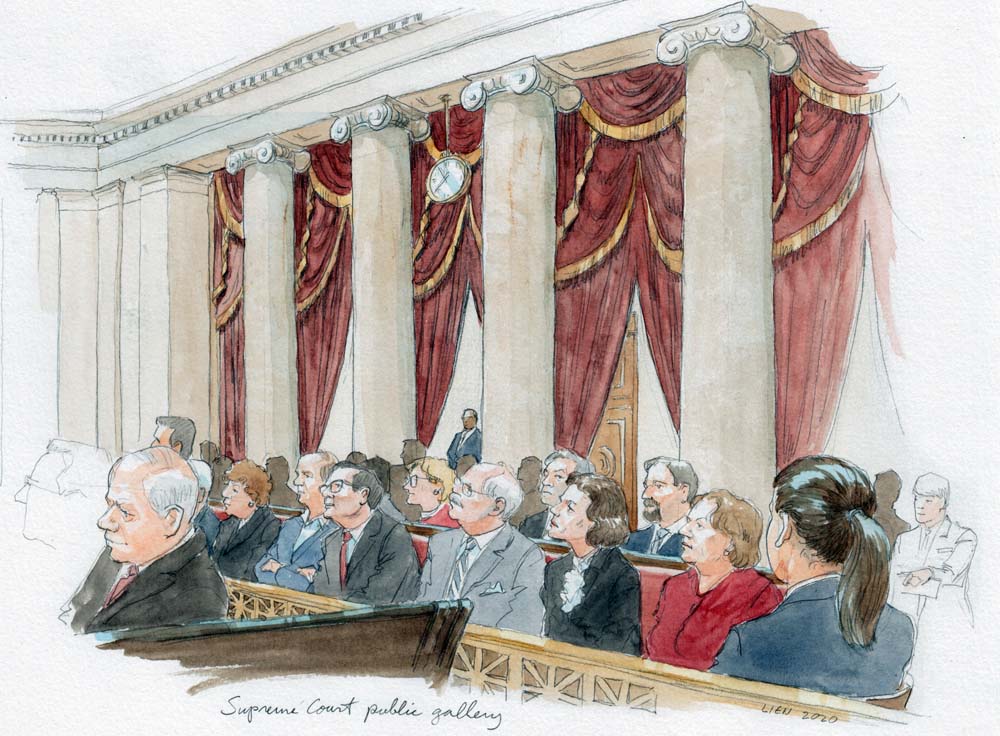FAQs: Announcements of orders and opinions


This post — which is an updated version of posts that we have published in earlier terms — addresses some of the questions about orders and opinion announcements that we have commonly received during our live blogs. If you have a question that you don’t see answered here, please feel free to ask it during today’s live blog.
ORDERS
Question: What do you mean by “orders”?
Answer: When we talk about “orders” or the “order list,” we are usually referring to the actions that the court took at its most recent conference, which are reflected in a document (“the order list”) that the court releases to the public. The most common orders are those granting or denying review on the merits in a particular case (known as granting or denying “cert,” short for “certiorari”), but the court may also issue other orders in cases seeking review or in pending cases — for example, an order granting or rejecting a request to participate in an oral argument on the merits.
Question: What is a “CVSG”?
Answer: “CVSG” stands for “call for the views of the solicitor general.” In most cases in which someone is seeking review of a lower court’s decision, the Supreme Court will issue a straightforward grant or denial. But sometimes the court will instead ask the government for its views on what the court should do with a particular petition for review, particularly in cases in which the government isn’t a party but may still have an interest — for example, because the interpretation of a federal statute is involved. In this scenario, the court will issue an order in which it invites the U.S. solicitor general, the government’s chief lawyer before the Supreme Court, to file a brief “expressing the views of the United States.” It isn’t an “invitation” in the sense that the federal government gets to decide whether it wants to file a brief at all, because the court expects the government to file. There is no deadline by which the government is required to file the brief; when the brief is filed, the government’s recommendation, although not dispositive, will carry significant weight with the court.
Question: What does it mean to relist a case?
Answer: When a case is relisted, that means the justices do not grant or deny review, but instead will reconsider the case at their next conference. This will be reflected on the case’s electronic docket once the docket has been updated: You will see the words “DISTRIBUTED for Conference of [fill in date],” and then the next entry in the docket will usually say “DISTRIBUTED for Conference of [next conference after the previous entry, whenever that is].” It is almost impossible to know exactly what is happening when a particular case is relisted, but a few different things could be going on. One justice could be trying to pick up a fourth vote to grant review, one or more justices just want to look more closely at the case, a justice could be writing an opinion about the court’s decision to deny review, or the court could be writing an opinion to summarily (that is, without briefing or oral argument on merits) reverse the decision below. In 2014, the court appears to have adopted a general practice of granting review only after it has relisted a case at least once; although we don’t know for sure, presumably the court uses the extra time resulting from a relist to make sure that the case is a suitable one for its review.
Question: What does it mean to reschedule a case?
Answer: When a case is rescheduled, the justices will consider the case at a different conference than the one for which it had originally been scheduled. Unlike relisted cases, which are considered at one conference and then set for reconsideration at the next conference, rescheduled cases are moved to a new conference without first having been considered. Rescheduled cases are similar to relisted cases, however, in that it is almost impossible to know exactly why particular case is rescheduled.
OPINIONS
Question: What opinions will the court issue today?
Answer: Unlike some other courts, the Supreme Court doesn’t announce in advance which cases will be decided on a particular day. So normally, we don’t know which opinions we will get on a particular day. The only time we have a good sense is the very last day, when the court issues its final rulings.
Question: How many opinions will the court issue?
Answer: The court also does not announce in advance how many opinions it expects to release on any particular day.
Question: What’s the last day the court will issue opinions?
Answer: We don’t know what the last day of the term will be. Monday, June 24, is currently the last day that the justices are scheduled to sit on the bench, but if they haven’t released all of their opinions by then, they could add additional decision days.
Question: If a case is not decided by the end of the term, will it be reargued?
Answer: Ordinarily, yes, the court will order reargument during the next term. But it’s relatively rare for the court to order reargument, particularly if it hasn’t asked the lawyers in the case to address a new question.
Question: Who announces “per curiam” opinions (that is, opinions without a named author)?
Answer: As he did earlier this term with Frank v. Gaos, Chief Justice John Roberts typically announces per curiam opinions in argued cases. The court will also issue a one-sentence per curiam opinion in the event of a tie; that normally comes from the chief justice. Per curiam opinions in cases that were not briefed and argued on the merits are typically issued with the order list and not otherwise announced.
Question: How does the court decide the order in which opinions will be announced on a given day?
Answer: The justices normally announce their opinions in order of reverse seniority, with the chief justice going last. This means that if Justice Brett Kavanaugh has an opinion to announce, he goes first, followed by Justice Neil Gorsuch, Justice Elena Kagan, and so on through the chief justice, who is always the most senior justice. However, there can be exceptions to this general reverse-seniority rule, generally when the justices are announcing decisions in two or more cases involving similar issues and it makes more sense to announce one first, even if it means disrupting the normal order for announcements. The justice who is announcing a decision will read a summary of the opinion out loud in the courtroom; the audio of this announcement will be available later at the Oyez Project’s website. A justice who dissents also has the option to read a summary of the dissent from the bench, but this is usually done only when the dissenting justice feels especially strongly about the case; the decision to read a dissent from the bench is generally regarded as a “statement” by the dissenting justice.
Question: How do you get the results in the cases? Do you have someone in the courtroom?
Answer: No electronic devices are allowed in the courtroom, and therefore no blogging can be done from the courtroom. So that I can live-blog for SCOTUSblog, I am in the press room. As soon as the court begins to announce an opinion in the courtroom, the court’s Public Information Office hands out paper copies of the opinion to the reporters in the press room. I quickly review the opinion and then type the result into the live blog. Because it can often take a few minutes for the author of an opinion to get to the bottom line while reading a summary of the decision, this means that we usually have the result in the case before the spectators in the courtroom do. The opinions are usually available on the court’s website shortly after they are released at the court.
Question: Who decides which justice will write which opinion?
Answer: Shortly after the oral argument, the justices vote on a case. The most senior justice in the majority gets to assign the author of the opinion. He can assign it to himself or to a colleague he thinks will be able to hold the majority.
Question: After voting, while the opinions are being drafted, do the justices ever change their votes?
Answer: The justices do sometimes change their votes. But unless the news leaks from the court, the public generally does not know for sure that this has happened until much later – for example, when a justice leaves the court and releases her papers.
Question: Does the court notify the lawyers in advance when it is going to issue an opinion in their case?
Answer: The court does not notify any of the lawyers in a case before it issues an opinion. So unless it is the last day before the summer recess, the lawyers (like the rest of us) don’t know whether they will get a decision in their cases. But even without knowing when they will get a decision, some lawyers like to attend the opinion announcements in the hope that the court will issue a decision that day.
Question: Can the public attend the sessions in which the court announces its decisions, or do you need a press pass?
Answer: The court usually makes at least 50 seats in the courtroom available to the public when the court is in session to hear arguments or announce opinions. But lines can be long, especially as we get closer to the end of June and the chances of getting an opinion in one of the high-profile cases increase. (Journalist and teacher Steven Mazie once chronicled for this blog his experiences bringing a class to oral argument at the Supreme Court; much of his advice also applies to attending opinion announcements.) To sit in the public seats in the courtroom, you don’t need to wear a suit, but you will want to dress neatly. And get there early!
Question: Do I have any other options to follow the action in the courtroom? Is there video or audio coverage of the opinion announcement?
Answer: There are no cameras capturing the proceedings in the courtroom, so video is not available – live or otherwise. Nor is there live audio coverage of the opinion announcements: The proceedings are recorded, but the audio is not available until much later.
Question: What is all the talk about boxes?
Answer: Shortly before 10 a.m., the PIO brings out copies of the opinions in sealed boxes to distribute to the press. The number of boxes is often a rough proxy for how many opinions we are likely to get. But, as someone has observed on the live blog, that information is really only relevant for about 10 minutes, because pretty soon we find out how many opinions there actually are.
Posted in Plain English / Cases Made Simple